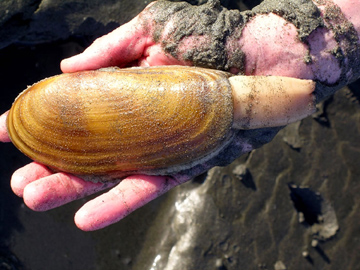Like a big-game hunter in an old jungle movie, the razor clam frequently plops into quicksand. In the clam’s case, though, it’s intentional – the clam makes the quicksand to help it sink into the sandy floor of the shallow waters it inhabits.
The Atlantic razor clam looks quite different from most other clams. In profile, it resembles the handle of an old straight razor – hence its name. It’s found along the Atlantic coast from Canada to South Carolina.
 Pacific razor clam. Credit: Washington Department of Fish and Wildlife
Pacific razor clam. Credit: Washington Department of Fish and WildlifeThe clam can burrow almost three feet deep in just a minute or two. But it’s not heavy enough to just sink through the sand, and its long “foot” isn’t strong enough to pull it down to more than an inch or so.
A recent study revealed the details on just how the clam burrows so deep. Researchers at MIT filled the bottom of a tank with tiny glass beads that resemble grains of sand, and topped it off with water. They then dropped in some Atlantic razor clams caught along the coast of Massachusetts, and recorded the clams on video.
They found that a clam first extended its long, muscular foot into the sand. It then squeezed shut its narrow shell, which allowed water to flow into the sand below it. That basically turned a small pocket of sand into quicksand. The clam then extended its foot a little farther and pulled itself a little deeper. It could repeat the process many times, burrowing deeper with each repetition.
So unlike the doomed hunters in old movies, the razor clam keeps safe by dropping into quicksand, not floating out of it.

